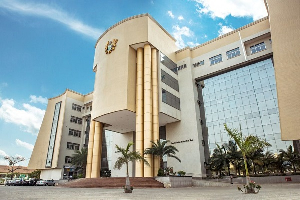Last week, the Central Bank announced an increase in the prime rate from 17% to 18.5%. And even though sections of the public criticized the policy decision, the Bank strongly defends it. The decision to do this in order to curb inflation in the country was justified by Director of Research at the Bank, Dr. Ernest Addison.
In this article, I want us to explore some ramifications of using higher prime rate (monetary contraction) to reduce inflation, given that H.E. President Mills is embarking on fiscal restriction. I stand to be corrected and so I dare not pontificate.
It was Nobel Laureate Milton Friedman (1963) who said “Inflation is always and everywhere a monetary phenomenon”. The measure by the Central Bank to check inflation is appropriate in the light of this monetarists’ philosophy. But let’s not forget that the Philips curve hypothesis (first propounded by William Philips and later augmented by Edmund Phelps) has unemployment as inflation’s trade-off. “We can’t eat our cake and have it”, you know.
Reducing fiscal deficit amounts to fiscal contraction. This dampens aggregate demand and has the tendency to reduce output and prices, ultimately. Now in order to avoid lower output, a contractionary fiscal policy should be accompanied by an expansionary monetary policy. The idea is to ensure output does not decline following the fiscal contraction.
We know that an increase in the prime rate is inevitably going to catapult average lending rates unto some higher trajectory of 30% and above. What this does is to make the cost of borrowing to do business pretty high (and unbearable). So it’s going to affect investment, big time! Let’s see how: Suppose you were a businessman. And you produce 100 bags of some commodity per month, using say 20 workers. You used to borrow from commercial banks at 25%. Now the new prime rate causes the banks to charge you interest of 35%. Borrowing the same amount you used to borrow is now expensive for you. So you’re forced, given your constraints, to borrow less. This also means that you can no longer produce the 100bags you used to. So you decide to produce 80 bags per month. As a rational businessman, who aims to maximize profits, you won’t retain all of your 20 workers because some will now be underutilized. The best (and most likely) option for you would be to lay-off some of your workers. Once laid-off, they join the extant, long, tortuous queue of the unemployed! The increase in the prime rate has led to lower output (from 100 bags per month to 80bags per month) and higher unemployment. Think about this for the entire nation with zillions of firms, each firing a few workers. I believe the broader picture should be clear now.
So, yes! The Bank of Ghana may have it right, that the way to curb inflation in Ghana is to reduce the money stock by increasing the prime rate. This is because as the Director indicated, fuel prices, which, alongside exchange rate, are very important determinants of inflation, fell last quarter. And the Cedi was relatively stable against major convertible currencies during the reference period. But is reducing inflation worth the lower output and higher unemployment the policy will trigger? I am of the conviction that on a cost-benefit basis, the “corrective measure” by the Central Bank is not rightly prioritized. Let’s not lose sight of the fact that inflation is both cost-pushed and demand-pulled. Having borrowed at higher interest rates, firms would most likely sell at higher prices. And given that output is now lower, inflationary pressures will continue to mount. More so, monetary contraction is only a necessary, but not a sufficient, condition for reducing inflation. The monetary aggregate target can be met; but one cannot state unambiguously that the monetary contraction will definitely curtail inflation.
Between 1975 and 1978, the federal Government of Canada decided to embark on Anti-Inflation Program due to soaring inflation in that country at the time. The role of the Bank of Canada was to use higher interest rates to reduce monetary aggregates, and eventually inflation. Through 1982, however, the monetary contraction was ineffective in reducing inflation as targeted by the Government. This is a perfect example for us, our structural differences notwithstanding.
Many will concur with me that increasing the prime rate would have been best if the economy were booming or overheated, in which case the raison d'être would have been to reduce output. But in our current economic situation when one can conveniently describe our economy as feeble, increasing the prime rate might turn out to be a “policy blunder”. The world is currently going through economic snags, emanating from the credit crunch. And I doubt whether there is any economy currently overheated to desire a lower output! My hope is that the Monetary Policy Committee will review the policy decision, and act accordingly to avert any economic misfortunes that might befall us as a corollary.
God Bless Ghana!
Iddisah Sulemana(iddisah@gmail.com)
Graduate Teaching Assistant
Department of Economics
The University of Akron
Ohio, USA
Opinions of Tuesday, 3 March 2009
Columnist: Sulemana, Iddisah














